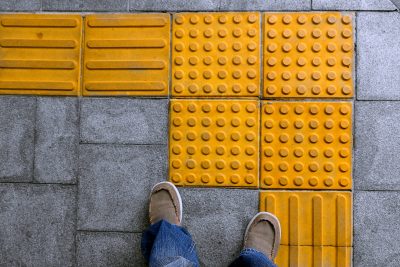Seiichi Miyake was a Japanese inventor who invented a system of block slabs to navigate the streets after learning a friend’s vision was becoming impaired. Originally known as Tenji Blocks, also commonly known as tactile blocks/domes today, they were first installed in Okayama City, Japan next to the Okayama School for the Blind on March 18, 1967.
There are a number of different patterns that have been designed since, but the blocks vary from small, raised bumps to pill-shaped, line bumps that function to signify different directional cues. These different textures serve as detectable warnings to help persons with a visual impairment or blindness to navigate around the city safely using their cane or feet to feel the path in front of them.
Most persons with a visual impairment have some degree of sight, so making the blocks brightly colored yellow and/or red makes them easier to identify traversing the streets.
With designs that vary slightly depending on where you are, they have become integrated around the world to discern pavement around metro areas, sidewalks, and other public places.
Meanings of Patterns on Tactile Paving
Here are some of the common patterns and their meanings.
- Offset dots – positioned in diagonal lines, indicates a train track or other ledge ahead
- Lozenge-shaped bumps – indicates an approach to the tracks of a street trolley, tram, or other street-level transportation
- Stripes across a path – indicates steps or other trip hazards ahead, for example, horizontal stripes before a set of stairs
- Stripes along a path – indicates a safe path to follow
Brightly colored and textured, these tactile paving systems benefit everyone, including persons living without a visual impairment.
When We Design for Inclusion, We All Benefit
A similar example of assistive technology that benefits everyone is the curb cut.
Curb cuts are a wedge cut in an elevated curb to allow smooth passage between the sidewalk and street. Originally installed to make public streets accessible to wheelchair users, they also ease the burden for anyone else that might be pushing a stroller, carrying heavy bags, or have joint pain.
Designing with inclusion in mind can also mean designing for web accessibility. If you, like many others, ever watch Netflix or YouTube with closed captions this is a perfect example. Captions were designed to help deaf people to understand movies without needing to hear dialogue or sound effects. However, it is incredibly helpful in educational settings to help students improve comprehension and accuracy in the classroom. Or it could help one binge-watch shows on a noisy commute.
Whatever the case may be, it is beneficial for everyone to look at designing our web experiences with accessibility in mind as our everyday lives are synonymous with online experiences as they are physical.
Curious to see if your website is accessible? Let us guide you on the path to accessibility and compliance!
